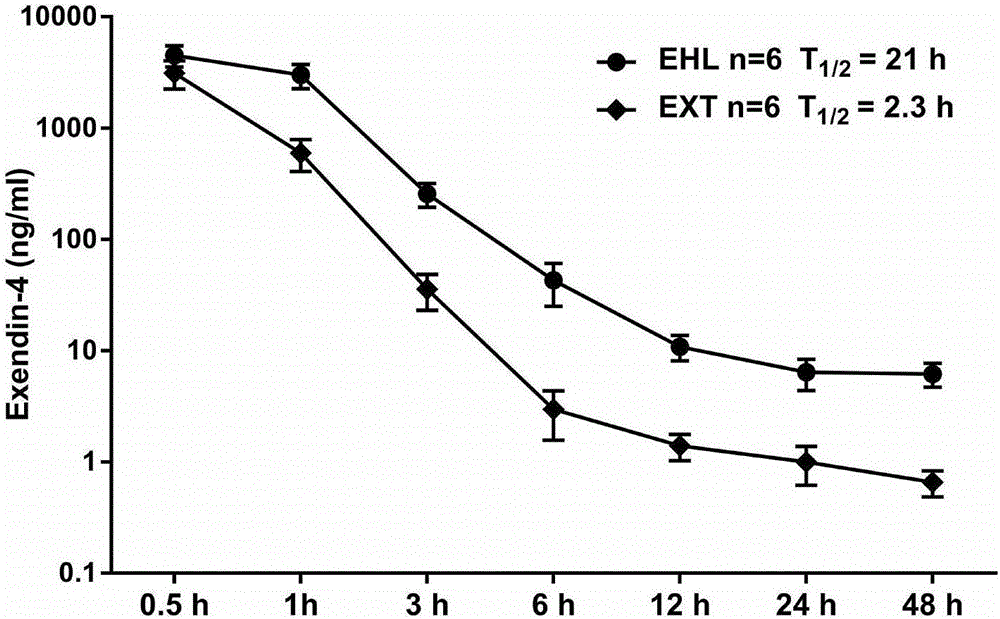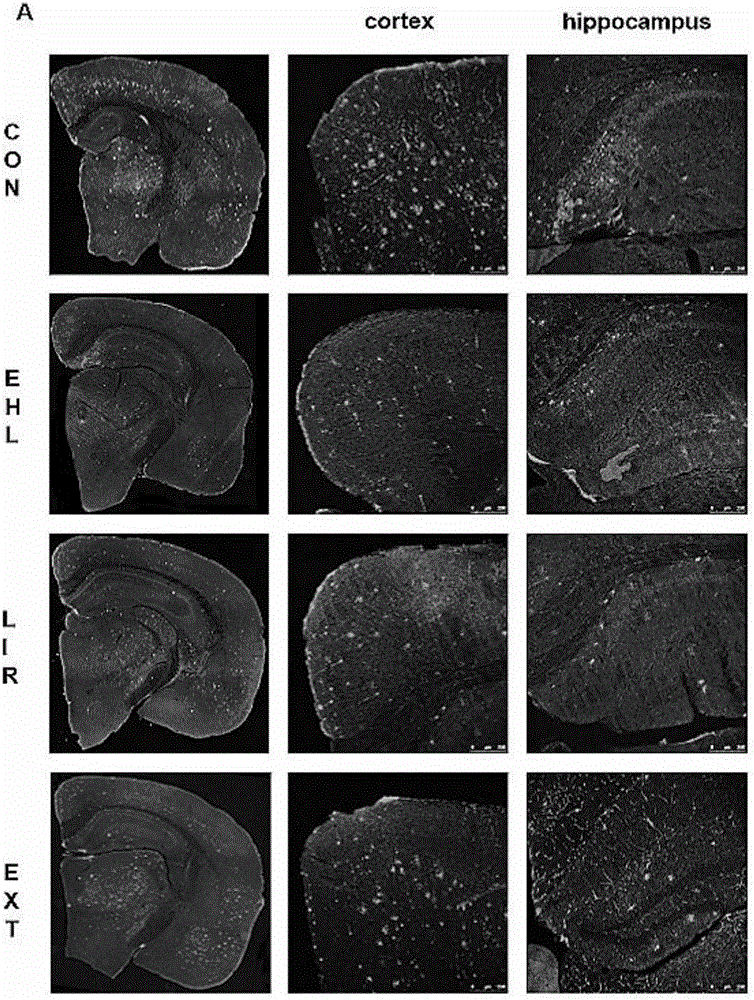Preparation method of novel GLP-1 receptor stimulant and applications of novel GLP-1 receptor stimulant in treatment field of neurodegenerative diseases
A receptor agonist, neurodegenerative technology, applied in the field of biomedicine, to achieve stable blood drug concentration, low production cost, and reduce toxic effects
- Summary
- Abstract
- Description
- Claims
- Application Information
AI Technical Summary
Problems solved by technology
Method used
Image
Examples
Embodiment 1
[0084] The preparation of embodiment 1 novel GLP-1 receptor agonist EHL
[0085] 1.1 Construction of EHL expression vector
[0086] The gene sequence of the gene synthesis EHL recombinant protein, the 3' end of the exenatide gene sequence is connected to the human fibronectin domain mutant (SEQ ID: 5 ) at the 5' end to obtain the EHL gene fragment, which was then constructed into an expression vector with a His tag and transformed into Escherichia coli.
[0087] 1.2 Induced expression of EHL
[0088] First, the Escherichia coli BL21 (DE3) expression strain transformed with the EHL recombinant plasmid was used for the first expansion culture with 2YT-Km medium) as the seed solution. Then, at a ratio of 0.1-0.5%, the seed solution was inoculated into a shake flask containing 2L 2YT medium for the second fermentation culture. When growing to the logarithmic growth phase, IPTG with a final concentration of 1mM was added and then induced overnight at 25 degrees. For expression, ...
Embodiment 2
[0103] Example 2 Detection of novel GLP-1 receptor agonist EHL half-life
[0104] 2.1 Grouping of experimental animals and preparation of specimens
[0105] (1) 5-month-old male SPF grade C57BL / 6J mice were selected and randomly divided into two groups: a novel GLP-1 receptor agonist group (EHL group) and an exenatide group (EXT group), with 5- Six rats were given a single intraperitoneal injection of EHL / EXT (125nmol / kg). At 7 time points (0.5, 1, 3, 6, 12, 24, 48 hours) after the administration, 100 μl of blood was collected from the orbit and placed in a 1.5ml centrifuge tube, overnight at 4°C.
[0106] (2) Centrifuge at 1000g for 20 minutes, label the supernatant, aliquot and store at -80°C to avoid repeated freezing and thawing.
[0107] 2.2 ELISA detection of Exendin-4 concentration in serum
[0108] (1) 25 minutes to 45 minutes before using the kit (PHOENIX, USA), make all the items in the kit reach room temperature.
[0109] (2) Dilute 50ml of 20× buffer, and dilut...
Embodiment 3
[0125] The therapeutic effect of embodiment 3 novel GLP-1 receptor agonists on AD model mice
[0126] 3.1 Test animals and their genotype identification
[0127] 5XFAD transgenic mice were bred and bred under standard conditions in an SPF grade animal room. The temperature was controlled at 25°C±2°C, the humidity was 45%-65%, free to eat and drink and water, and the light was cycled 12:12 hours a day and night. Newborn mice were tail-cut at 7-14 days after birth for genotype identification, and were divided into cages according to gender at 21-24 days after birth, with no more than 5 mice per cage. 5XFAD (heterozygous, HET) female mice aged 2-3 months were mated with C57BL / 6J male mice. 5XFAD heterozygous (HET) mice and wild-type (WT) mice were bred. 5XFAD heterozygous male mice were used for the experiment.
[0128] Genomic DNA extraction:
[0129] (1) Cut the tail of the mouse 7-14 days after birth, and place it in a 1.5mL EP tube;
[0130] (2) Prepare DNA lysate: ddH2...
PUM
| Property | Measurement | Unit |
|---|---|---|
| molecular weight | aaaaa | aaaaa |
| molecular weight | aaaaa | aaaaa |
| molecular weight | aaaaa | aaaaa |
Abstract
Description
Claims
Application Information
 Login to View More
Login to View More - R&D
- Intellectual Property
- Life Sciences
- Materials
- Tech Scout
- Unparalleled Data Quality
- Higher Quality Content
- 60% Fewer Hallucinations
Browse by: Latest US Patents, China's latest patents, Technical Efficacy Thesaurus, Application Domain, Technology Topic, Popular Technical Reports.
© 2025 PatSnap. All rights reserved.Legal|Privacy policy|Modern Slavery Act Transparency Statement|Sitemap|About US| Contact US: help@patsnap.com



